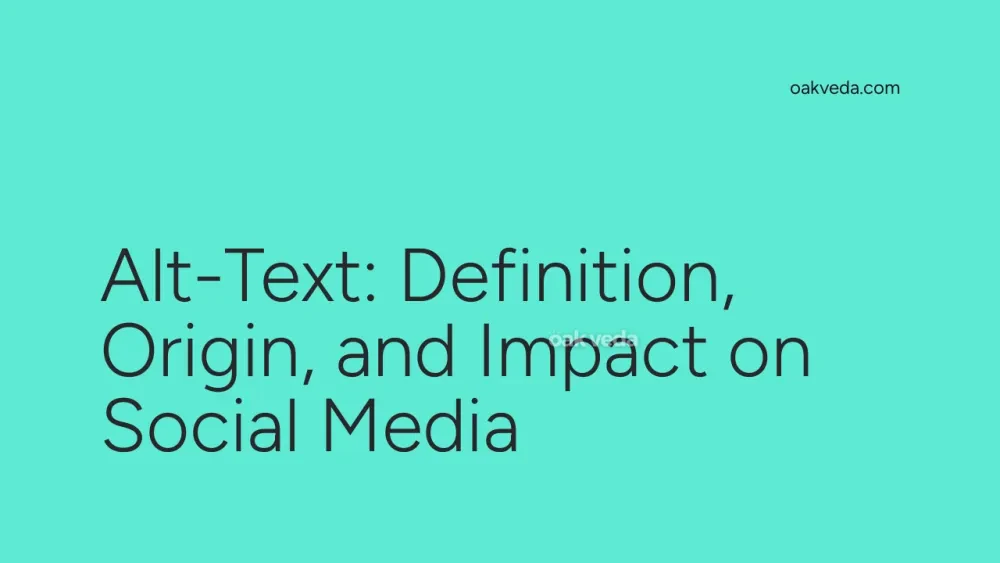
What is Alt-Text?
Alt-text, short for alternative text, is a crucial element in digital accessibility and search engine optimization (SEO). It's a concise, descriptive text that explains the content and function of an image or video on a webpage or social media platform. Alt-text serves as a textual alternative for visual content, ensuring that all users, including those with visual impairments, can access and understand the information conveyed by images.
Origin and Development of Alt-Text
The concept of alt-text originated in the early days of the World Wide Web, as developers sought ways to make online content more accessible. The World Wide Web Consortium (W3C) introduced the alt attribute in HTML 2.0 in 1995, marking the official beginning of alt-text usage. Since then, alt-text has evolved from a simple accessibility feature to a multifaceted tool that enhances user experience, improves SEO, and supports social media engagement.
How Alt-Text Works
Alt-text functions by providing a textual description of visual content. When an image fails to load or when a user employs a screen reader, the alt-text is displayed or read aloud, respectively. On social media platforms, alt-text is typically added to images during the upload process, either manually or through automatic generation features.
For example, on Twitter, users can add alt-text to images by enabling the feature in their accessibility settings and then adding descriptions when uploading images. Similarly, Facebook and Instagram offer options to add alt-text to photos, either manually or through AI-generated descriptions.
Types or Variations of Alt-Text
While alt-text is generally a single, concise description, there are variations in its application:
- Descriptive Alt-Text: Provides a detailed description of the image content.
- Functional Alt-Text: Describes the purpose or action of an image, often used for buttons or icons.
- Decorative Alt-Text: Used for images that are purely aesthetic and don't convey important information.
- Empty Alt-Text: Indicated by alt="", used when an image should be ignored by screen readers.
Popular Examples of Alt-Text
Many brands and influencers have embraced alt-text to make their content more inclusive. For instance:
- Microsoft: Consistently uses detailed alt-text across its social media platforms to describe product images and infographics.
- National Geographic: Provides rich, descriptive alt-text for its stunning photography on Instagram and Twitter.
- The New York Times: Includes comprehensive alt-text for images in its social media posts, enhancing accessibility for news content.
Impact of Alt-Text on Social Media Culture
Alt-text has significantly influenced social media culture by:
- Promoting Inclusivity: It has made social media more accessible to users with visual impairments, fostering a more inclusive online environment.
- Enhancing User Experience: Even for users without visual impairments, alt-text can provide context when images fail to load due to poor internet connections.
- Improving Content Discovery: By making images searchable, alt-text has changed how users find and engage with visual content on social platforms.
Controversies or Debates Surrounding Alt-Text
While generally viewed positively, alt-text has sparked some debates:
- Quality of AI-Generated Alt-Text: The accuracy and appropriateness of automatically generated descriptions have been questioned.
- Overuse of Keywords: Some marketers have been criticized for stuffing alt-text with keywords, prioritizing SEO over accessibility.
- Responsibility for Creation: Debates continue about whether content creators, platforms, or AI should be primarily responsible for generating alt-text.
How Brands and Influencers Use Alt-Text
Savvy brands and influencers leverage alt-text to:
- Improve Accessibility: Ensuring their content reaches the widest possible audience.
- Boost SEO: Enhancing image searchability and improving overall content visibility.
- Increase Engagement: Providing context that can encourage more interactions with their posts.
- Demonstrate Social Responsibility: Showing commitment to inclusivity and digital accessibility.
Future Trends Related to Alt-Text
The future of alt-text in social media looks promising:
- Advanced AI Generation: Improvements in AI will likely lead to more accurate and contextually relevant automated alt-text.
- Integration with AR/VR: As augmented and virtual reality become more prevalent in social media, alt-text may evolve to describe these immersive experiences.
- Standardization: We may see more unified guidelines and practices for alt-text across different platforms.
- User-Generated Alt-Text: Platforms might encourage users to contribute or edit alt-text, creating a more collaborative approach to accessibility.
FAQs about Alt-Text
-
How long should alt-text be? Ideally, alt-text should be concise yet descriptive, typically not exceeding 125 characters.
-
Is alt-text the same as image captions? No, alt-text is specifically for accessibility and SEO purposes, while captions are visible to all users and provide additional context.
-
Do all images need alt-text? While it's best practice to provide alt-text for most images, purely decorative images can use empty alt-text (alt="").
-
Can alt-text improve my social media reach? Yes, by making your content more accessible and searchable, alt-text can potentially increase your content's visibility and engagement.
-
How do I add alt-text on different social media platforms? Most major platforms like Facebook, Twitter, and Instagram offer options to add alt-text when uploading images. Check each platform's accessibility settings for specific instructions.
By embracing alt-text, social media users can create a more inclusive digital environment while also reaping the benefits of improved SEO and user engagement. As social media continues to evolve, the importance of alt-text in creating accessible, discoverable content is likely to grow, making it an essential skill for digital communicators.
You may be interested in:
- Content Marketing: Definition, Origin, and Impact
- Sheesh: Definition, Origin, and Impact on Social Media
- Doomscrolling: Definition, Origin, and Impact
- Cottagecore: Definition, Origin, and Impact on Social Media
- Brand Advocate: Definition, Origin, and Impact on Social Media
- Put on Blast: Definition, Origin, and Impact

